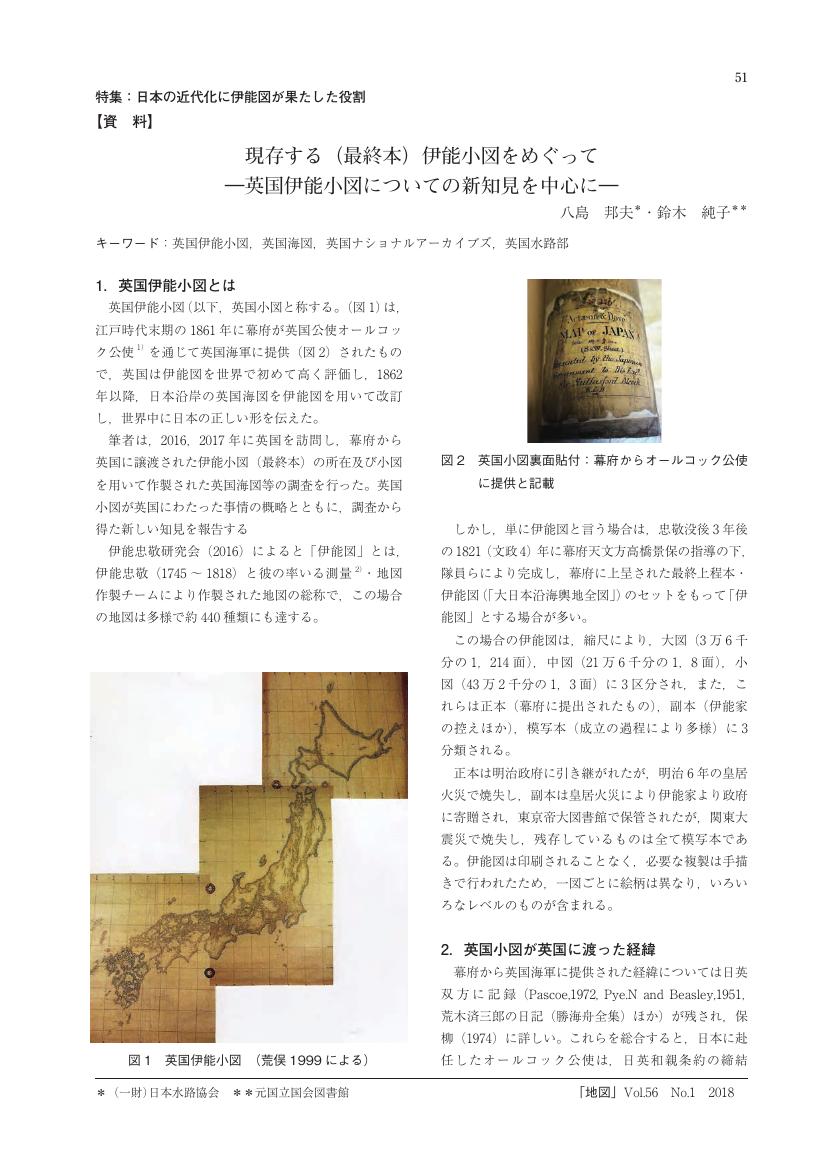1 0 0 0 OA マスクフィッティングテスターを用いたN95マスクの顔面密着性の定量的評価と装着指導
- 著者
- 川辺 芳子 田中 茂 永井 英明 鈴木 純子 田村 厚久 長山 直弘 赤川 志のぶ 町田 和子 倉島 篤行 四元 秀毅
- 出版者
- THE JAPANESE SOCIETY FOR TB AND NTM
- 雑誌
- 結核 (ISSN:00229776)
- 巻号頁・発行日
- vol.79, no.7, pp.443-448, 2004-07-15 (Released:2011-05-24)
- 参考文献数
- 12
- 被引用文献数
- 1
[目的] 防じんマスクの密着性の評価に使用されているマスクフィッティングテスターを用いてN95微粒子用マスク (N95マスク) の顔面への密着性の定量的評価を行うことの妥当性を検討することと, N95マスクの装着状況およびマスクの選択と使用方法の指導の重要性を明らかにすることを目的とする。 [対象] 当院に勤務する職員133名で, 男性29名, 女性104名, 常時N95マスクを使用している者は46名, 毎日は使用していない者87名であった。 [方法] 労研式マスクフィッティングテスターMT-02型TMを用いてマスクの漏れ率を測定し, 10%以下を許容範囲とした。基準に達しない場合は装着方法を指導し, それでも達しない場合はマスクの種類を変更した。 [結果] 1回目で漏れ率が10%以下であったのは87名 (65%) であった。10%を超えた46名のうち40名は指導やマスクの変更により10%以下になったが, 最終的に6名は達しなかった。マスクの選択, 鼻の部分の密着性, ゴムひもの使用方法が問題であった。 [結論] マスクフィッティングテスターはN95マスクの顔面への密着性の定量的評価に有用であり, 顔に合ったマスクの選択と日常的な指導点検, 3種類以上のマスクを準備しておくことが重要であることが明らかになった。
- 著者
- 八島 邦夫 鈴木 純子
- 出版者
- 日本地図学会
- 雑誌
- 地図 (ISSN:00094897)
- 巻号頁・発行日
- vol.56, no.1, pp.51-58, 2018
1 0 0 0 OA 現存する(最終本)伊能小図をめぐって ―英国伊能小図についての新知見を中心に―
1 0 0 0 OA 伊能図利用の軌跡
- 著者
- 鈴木 純子
- 出版者
- 日本地図学会
- 雑誌
- 地図 (ISSN:00094897)
- 巻号頁・発行日
- vol.56, no.1, pp.1_9-1_23, 2018-03-31 (Released:2019-06-17)
- 参考文献数
- 27
Inô-zu were the first accurate scientific survey maps of the entire coastline of Japanese archipelago officially presented to the shogun in 1821.It is generally said that the shogun shelved them in his library, and it was until the closing days of the Edo period nearly a half century later, that Inô-zu began to be utilized and appreciated. The donation of the small scale series of Inô-zu to the British fleet in 1861, and the official publication of them in 1867 were the scarce case known as its utilization under the Tokugawa Shogunate.However there were some cases other than the examples above showing the vestiges of the utilization of Inô-zu, such as the case of Sado Kuniezu (Provincial map of Sado) in the years of 1835-1836, the investigation of the coast of Edo bay for its security by officers of foreign affairs of the shogunal government in 1849, the coastal survey of Ise Bay in 1861 by the officers of the Navy, and some printed maps published in the same period. These examples show that the utilization of Inô-zu was not such strictly restricted as it has been long thought of. It seems that the each case properly take advantage of the feature of Inô-zu of accurately surveyed coastal maps.After Meiji Restoration Inô-zu served as bases and important data sources to meet the urgent needs of accurate scientific maps and charts and of the source of compilation of historiography and topography of Japan.According to several historical documents at that time, we know the Map of Japan(1:432,000 compiled by the Dajokan-Seiin(Grand Council of Japan)presented to the International Exhibition held at Vienna in 1873 was the first and the most prominent accomplishment of the modern style map based on Inô-zu. Unfortunately we can no longer trace its appearance because the map seems to have been lost now.Subsequently the utilization of the Inô-zu as the basic information has followed soon at official agencies such as the Bureau of Historiography, the Geographical Bureau, Ministry of Education, then prevailed widely in private enterprises. Inô-zu was also used as the base map for investigations of geology, soil, mines and so on.We can draw the conclusion from this review mentioned above that the appreciation of the basic property of Inô-zu : accurate coastal survey with graticule has been common understanding of those who utilized Inô-zu to develop their maps.
1 0 0 0 OA 伊能忠敬の測量事業にともなった学術的交流
- 著者
- 鈴木 純子
- 出版者
- 公益社団法人 東京地学協会
- 雑誌
- 地学雑誌 (ISSN:0022135X)
- 巻号頁・発行日
- vol.129, no.2, pp.161-179, 2020-04-25 (Released:2020-05-12)
- 参考文献数
- 28
- 被引用文献数
- 3
The accomplishments of the survey projects of Inoh Tadataka in early 19th century Japan should not be evaluated merely from the visible results of his maps of the country. The latest surveying technologies and instruments, as well as his knowledge of the astronomical almanac, had a wide range of influences upon the surveying skills and astronomical knowledge of local surveyors and scholars. Inoh's Sokuryo-nikki (Survey diary) and records of local counterparts preserved in throughout Japan are reviewed and connections are evaluated. The records have been unearthed in recent years by historians editing regional histories and local history researchers. These investigations are important aspects of recent studies of Inoh's projects and supplement basic research of Otani (1917) and Hoyanagi (1974). During his journeys to survey Japan over seventeen years, Inoh kept a daily journal. It records some 12,000 people who attended or guided Inoh's team. However, his journal lacks details of connections among them. Local records contain extensive practical information concerning the project. Generally, officials of local lords or village officials accompanied the team of surveyors. They would learn on the job. According to their records and letters, some made and improved upon Inoh's surveying instruments. Others wanted to become students of Inoh and later attended private classes in Edo. Still others discussed calendrical calculations, trigonometric functions, and logarithm. Subsequently, some returned to their home regions and took charge of local surveys. As a result, we can recognize the wide range of influences the surveying project of Inoh Tadataka had.
- 著者
- 鈴木 純子
- 出版者
- 東京大学史料編纂所
- 雑誌
- 東京大学史料編纂所研究紀要 (ISSN:09172416)
- 巻号頁・発行日
- no.23, pp.66-78,図巻頭2枚, 2013-03
1 0 0 0 OA 大学生の食事摂取状況と食生活に関する行動変容段階
- 著者
- 鈴木 純子 荒川 義人 森谷 潔
- 出版者
- 北海道大学大学院
- 雑誌
- 北海道大学大学院教育学研究科紀要 (ISSN:13457543)
- 巻号頁・発行日
- vol.88, pp.247-258, 2003-02
